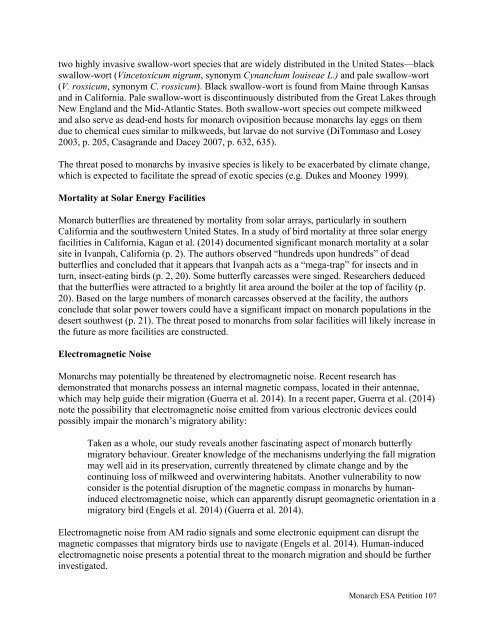monarch-esa-petition-final_61585
monarch-esa-petition-final_61585
monarch-esa-petition-final_61585
You also want an ePaper? Increase the reach of your titles
YUMPU automatically turns print PDFs into web optimized ePapers that Google loves.
two highly invasive swallow-wort species that are widely distributed in the United States—black<br />
swallow-wort (Vincetoxicum nigrum, synonym Cynanchum louiseae L.) and pale swallow-wort<br />
(V. rossicum, synonym C. rossicum). Black swallow-wort is found from Maine through Kansas<br />
and in California. Pale swallow-wort is discontinuously distributed from the Great Lakes through<br />
New England and the Mid-Atlantic States. Both swallow-wort species out compete milkweed<br />
and also serve as dead-end hosts for <strong>monarch</strong> oviposition because <strong>monarch</strong>s lay eggs on them<br />
due to chemical cues similar to milkweeds, but larvae do not survive (DiTommaso and Losey<br />
2003, p. 205, Casagrande and Dacey 2007, p. 632, 635).<br />
The threat posed to <strong>monarch</strong>s by invasive species is likely to be exacerbated by climate change,<br />
which is expected to facilitate the spread of exotic species (e.g. Dukes and Mooney 1999).<br />
Mortality at Solar Energy Facilities<br />
Monarch butterflies are threatened by mortality from solar arrays, particularly in southern<br />
California and the southwestern United States. In a study of bird mortality at three solar energy<br />
facilities in California, Kagan et al. (2014) documented significant <strong>monarch</strong> mortality at a solar<br />
site in Ivanpah, California (p. 2). The authors observed “hundreds upon hundreds” of dead<br />
butterflies and concluded that it appears that Ivanpah acts as a “mega-trap” for insects and in<br />
turn, insect-eating birds (p. 2, 20). Some butterfly carcasses were singed. Researchers deduced<br />
that the butterflies were attracted to a brightly lit area around the boiler at the top of facility (p.<br />
20). Based on the large numbers of <strong>monarch</strong> carcasses observed at the facility, the authors<br />
conclude that solar power towers could have a significant impact on <strong>monarch</strong> populations in the<br />
desert southwest (p. 21). The threat posed to <strong>monarch</strong>s from solar facilities will likely increase in<br />
the future as more facilities are constructed.<br />
Electromagnetic Noise<br />
Monarchs may potentially be threatened by electromagnetic noise. Recent research has<br />
demonstrated that <strong>monarch</strong>s possess an internal magnetic compass, located in their antennae,<br />
which may help guide their migration (Guerra et al. 2014). In a recent paper, Guerra et al. (2014)<br />
note the possibility that electromagnetic noise emitted from various electronic devices could<br />
possibly impair the <strong>monarch</strong>’s migratory ability:<br />
Taken as a whole, our study reveals another fascinating aspect of <strong>monarch</strong> butterfly<br />
migratory behaviour. Greater knowledge of the mechanisms underlying the fall migration<br />
may well aid in its preservation, currently threatened by climate change and by the<br />
continuing loss of milkweed and overwintering habitats. Another vulnerability to now<br />
consider is the potential disruption of the magnetic compass in <strong>monarch</strong>s by humaninduced<br />
electromagnetic noise, which can apparently disrupt geomagnetic orientation in a<br />
migratory bird (Engels et al. 2014) (Guerra et al. 2014).<br />
Electromagnetic noise from AM radio signals and some electronic equipment can disrupt the<br />
magnetic compasses that migratory birds use to navigate (Engels et al. 2014). Human-induced<br />
electromagnetic noise presents a potential threat to the <strong>monarch</strong> migration and should be further<br />
investigated.<br />
Monarch ESA Petition 107




